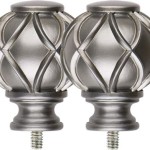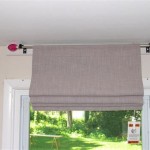How to Make Tie Backs for Curtains
Curtain tie backs are functional and decorative accessories that hold curtains open, allowing natural light to enter a room while adding to the overall aesthetic. They can be crafted from a variety of materials, each lending a unique style to the window treatment. Creating tie backs is a relatively simple project that can be customized to match existing décor or to introduce a new design element.
This article provides detailed instructions on how to make tie backs for curtains using different methods and materials, catering to various skill levels and design preferences. The focus will be on clarity and practicality, ensuring that the reader can successfully create tie backs that are both functional and visually appealing.
Fabric Tie Backs with Interfacing
Fabric tie backs are a versatile option that can be made from a wide range of materials, from lightweight cotton to more substantial upholstery fabrics. Interfacing provides structure and prevents the tie back from drooping or losing its shape. This method involves sewing, making it suitable for individuals with basic sewing skills.
Materials Required:
- Fabric (approximately ¼ yard, depending on desired length and width)
- Interfacing (similar amount as fabric)
- Sewing machine
- Thread (matching fabric color)
- Scissors
- Measuring tape or ruler
- Pins
- Iron
- Optional: Decorative trim, buttons, or embellishments
Step 1: Measuring and Cutting the Fabric and Interfacing. The first step involves determining the desired length and width of the tie back. A standard length is typically between 18-24 inches, but this can be adjusted based on the size of the window and the thickness of the curtains. The width is usually between 2-4 inches. Add a seam allowance of ½ inch on all sides. For instance, if the desired finished dimensions are 20 inches long and 3 inches wide, cut the fabric and interfacing to 21 inches long and 4 inches wide. Cut two pieces of fabric and one piece of interfacing to these dimensions.
Step 2: Applying the Interfacing. Place the interfacing on the wrong side of one piece of fabric. Using a hot iron, fuse the interfacing to the fabric according to the manufacturer's instructions. Ensure that the interfacing is securely bonded to the fabric to provide adequate support.
Step 3: Sewing the Fabric Pieces Together. Place the two fabric pieces right sides together, aligning the edges. Pin the fabric securely to prevent shifting during sewing. Using a sewing machine, stitch around the perimeter of the tie back, leaving a 3-4 inch opening on one of the long sides. This opening will be used to turn the tie back right side out.
Step 4: Trimming and Turning. Trim the corners of the sewn fabric to reduce bulk. This will create sharper corners when the tie back is turned right side out. Carefully turn the tie back right side out through the opening. Use a point turner or a blunt object to gently push out the corners.
Step 5: Pressing and Finishing. Press the tie back with an iron, paying particular attention to the edges. Fold in the raw edges of the opening and press them in place. Hand-stitch the opening closed using a blind stitch or topstitch around the entire perimeter of the tie back using a sewing machine for a more secure and decorative finish.
Step 6: Adding Embellishments (Optional). This is the stage to personalize the tie backs. Decorative trim, such as ribbon, lace, or braid, can be sewn along the edges of the tie back. Buttons, beads, or other embellishments can be added to the center or ends of the tie back for a more decorative effect. Consider the overall style of the room and choose embellishments that complement the existing decor.
Rope Tie Backs with Tassels
Rope tie backs offer a rustic or nautical aesthetic, depending on the type of rope used. Adding tassels to the ends enhances the decorative appeal. This method requires minimal sewing and is suitable for beginners.
Materials Required:
- Rope (approximately 3 feet per tie back, depending on desired length)
- Embroidery floss or yarn (for tassels)
- Scissors
- Measuring tape or ruler
- Hot glue gun and glue sticks (optional, for securing tassel ends)
Step 1: Measuring and Cutting the Rope. Determine the desired length of the tie back. As a general guideline, 3 feet of rope should be sufficient, but this may need to be adjusted based on the size and style of the curtains. Cut the rope to the desired length using sharp scissors.
Step 2: Making the Tassels. To create the tassels, wrap the embroidery floss or yarn around a piece of cardboard or a book that is approximately 3-4 inches wide. Wrap the floss or yarn around the cardboard multiple times (approximately 30-40 times) to create a full tassel. Carefully slide the floss or yarn off the cardboard. Cut a separate piece of floss or yarn and tie it tightly around the top of the loop to create the tassel head. Wrap the floss or yarn around the head several times and secure it with a knot. Trim the ends of the floss or yarn to create an even tassel.
Step 3: Attaching the Tassels. Attach the tassels to the ends of the rope. Fold the rope end over by approximately ½ inch and secure it with a knot. Attach the tassel to the looped end of the rope, using either a knot or hot glue to secure it. Ensure that the tassel is securely attached to the rope to prevent it from falling off. Repeat the process for the other end of the rope.
Step 4: Finishing Touches (Optional). For a more polished look, consider adding beads or other decorative elements to the rope. These can be threaded onto the rope before attaching the tassels. Braiding the rope can also add visual interest and texture. Secure the ends of the braid with knots or by wrapping them with floss or yarn.
Beaded Wire Tie Backs
Beaded wire tie backs offer a more intricate and decorative option. They can be customized with a variety of beads to match the color scheme and style of the room. This method requires some dexterity and basic jewelry-making skills.
Materials Required:
- Wire (approximately 3 feet per tie back, 18-20 gauge is recommended)
- Beads (various sizes and colors)
- Wire cutters
- Pliers (round-nose and flat-nose)
- Measuring tape or ruler
- Optional: Crimping beads
Step 1: Preparing the Wire. Cut the wire to the desired length. As with the rope tie backs, 3 feet is a good starting point, but this may need to be adjusted based on the size of the window and the weight of the curtains. Straighten the wire as much as possible using pliers.
Step 2: Stringing the Beads. Begin stringing the beads onto the wire. Alternate the sizes and colors of the beads to create a visually appealing pattern. Leave approximately 2-3 inches of bare wire at each end of the tie back for creating loops or attaching hooks.
Step 3: Creating Loops or Attaching Hooks. Use the round-nose pliers to create a loop at each end of the tie back. This loop will be used to attach the tie back to a hook or to another part of the curtain. Alternatively, crimping beads can be used to secure the ends of the wire and attach hooks or clasps. To use crimping beads, thread the wire through the crimping bead, then through the loop of the hook or clasp, and back through the crimping bead. Use the flat-nose pliers to crimp the bead tightly, securing the hook or clasp to the wire.
Step 4: Adding Finishing Touches (Optional). Consider adding charms or other decorative elements to the tie back. These can be attached to the loops at the ends of the tie back using jump rings. For a more secure hold, apply a small amount of glue to the knots or crimps.
Choosing the Right Materials and Style
The selection of materials for curtain tie backs significantly impacts their overall appearance and functionality. Fabric choices should complement the curtains and the room's decor. For lightweight curtains, lighter fabrics like cotton or linen are suitable, while heavier curtains may require more substantial fabrics like upholstery or drapery weight materials. Interfacing is crucial for providing structure and preventing the tie back from sagging.
Rope tie backs introduce a nautical or rustic touch, and the type of rope used can further refine the style. Natural fibers like jute or hemp offer a more organic look, while synthetic ropes can provide durability and resistance to moisture. The addition of tassels, beads, or braids can enhance the decorative appeal of rope tie backs.
Beaded wire tie backs offer a customizable and elegant option. The choice of beads can reflect the room's color scheme and style, and the wire gauge should be appropriate for the weight of the beads and the curtains. Consider using memory wire for a more structured and sculptural tie back.
Beyond the core materials, embellishments play a crucial role in personalizing curtain tie backs. Buttons, ribbons, lace, charms, and other decorative elements can be added to reflect individual taste and complement the overall design. Consider the scale and placement of embellishments to ensure a balanced and harmonious look.
Securing and Using Tie Backs
The method of securing tie backs to the wall or curtain panel is an important consideration. Several options are available, each with its own advantages and disadvantages. Hooks are a common choice, providing a simple and secure way to hold the tie back in place. Hooks can be mounted on the wall using screws or adhesives, depending on the weight of the curtains and the wall material.
Another option is to use curtain tie back holders, which are decorative hardware pieces designed specifically for this purpose. These holders typically feature a loop or hook that protrudes from the wall, allowing the tie back to be easily attached and removed. Tie back holders are available in a variety of styles and finishes to complement the room's decor.
For a less permanent solution, consider using magnetic tie backs. These consist of two magnets that attach to the curtain panel, holding it in place. Magnetic tie backs are easy to use and can be repositioned as needed, but they may not be suitable for very heavy curtains. Alternatively, Velcro straps can be sewn onto the tie back and the curtain panel, providing a secure and adjustable hold.
The height at which the tie back is positioned also affects the appearance and functionality of the curtains. A general guideline is to place the tie back approximately one-third of the way up from the bottom of the curtain panel. However, this can be adjusted based on the size of the window and the desired amount of light and privacy. Experiment with different heights to find the optimal position for each window.
Proper maintenance is essential for ensuring the longevity of curtain tie backs. Fabric tie backs can be laundered or dry-cleaned as needed, following the care instructions for the fabric. Rope tie backs can be spot-cleaned with a mild detergent and water. Beaded wire tie backs should be cleaned with a soft cloth to remove dust and dirt. Avoid using harsh chemicals or abrasive cleaners, as these can damage the materials.
Regularly inspect tie backs for signs of wear and tear, such as loose seams, frayed edges, or broken beads. Repair any damage promptly to prevent further deterioration. Store tie backs in a dry, clean place when not in use to protect them from dust, moisture, and sunlight.

Diy Curtain Tie Backs Unique Functional And Decorative Ideas Hello Sewing

Diy Faux Curtains How To Sew Tieback

Easy Curtain Tie Backs Best Fabric Blog

Diy Easy Sew Curtain Tieback Tutorial

64 Diy Curtain Tie Backs Guide Patterns

5 Easy And Stylish Diy Curtain Tieback Ideas

Diy Curtain Tiebacks Craft Your Unique Look Pardewale In

Quick And Easy Diy Curtain Tie Backs

Boho Curtain Holder Diy Beautiful Home Stuff How To Make Tie Back For Curtains Decor

18 Diy Curtain Tie Back Ideas How To Make Them Mama And More








